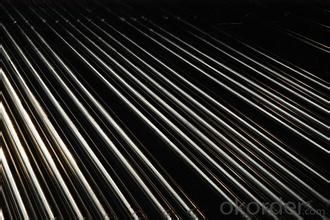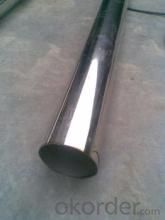Stainless Seamless Steel Pipes With Good Price
- Loading Port:
- China main port
- Payment Terms:
- TT or LC
- Min Order Qty:
- 100 m.t.
- Supply Capability:
- 10000 m.t./month
OKorder Service Pledge
OKorder Financial Service
You Might Also Like
1、Structure of Seamless Pipe :
Seamless pipe is formed by drawing a solid billet over a piercing rod to create the hollow shell. As the manufacturing process does not include any welding, seamless pipes are perceived to be stronger and more reliable.
2、Main Features of the Seamless Pipe :
• Small inertia resistance
• Strong heat dissipation ability
• Good visual effect
• Reasonable price
• High manufacturing accuracy
• High strength
3、Seamless Pipe ASTM A106/53 Specification:
Standard | GB, DIN, ASTM ASTM A106-2006, ASTM A53-2007 |
Grade | 10#-45#, 16Mn 10#, 20#, 45#, 16Mn |
Thickness | 8 - 33 mm |
Section Shape | Round |
Outer Diameter | 133 - 219 mm |
Place of Origin | Shandong, China (Mainland) |
Secondary Or Not | Non-secondary |
Application | Hydraulic Pipe |
Technique | Cold Drawn |
Certification | API |
Surface Treatment | factory state or painted black |
Special Pipe | API Pipe |
Alloy Or Not | Non-alloy |
Length | 5-12M |
Outer Diameter | 21.3-610mm |
Grade | 20#, 45#, Q345, API J55, API K55, API L80, API N80, API P110, A53B |
Standard | ASME, ASTM |
1) Material:20#(ASTM A 106/A53 GRB.API5LGRB,GB),45#,16Mn,10#.
2) Specification range:OD:21.3-610mm,WT:6-70mm,length:6-12m or according to the requirement of clients.
3) Surface:black lacquered,varnish coating or galvanized.
4) Ends:Beveled or square cut,plastic capped,painted.
5) Packing:bundles wrapped with strong steel strip,seaworthy packing.
4、Packaging & Delivery
Packaging Details: | seaworthy package,bundles wrapped with strong steel strip |
Delivery Detail: | 15-30days after received 30%TT |
5、FAQ of Seamless Pipe :
①How is the quality of your products?
If you want see our quality certifications and all kinds of testing report, please just ask us for it.
Guaranteed: If products’ quality don’t accord to discription as we give or the promise before you place order, we promise 100% refund.
②How about price?
Yes, we are factory and be able to give you lowest price below market one, and we have a policy that “ for saving time and absolutely honest business attitude, we quote as lowest as possible for any customer, and discount can be given according to quantity”,if you like bargain and factory price is not low enough as you think, just don’t waste your time.Please trust the quotation we would give you, it is professional one.
③Why should you chose us?
Chose happens because of quality, then price, We can give you both.Additionally, we can also offer professional products inquiry, products knowledge train(for agents), smooth goods delivery, exellent customer solution proposals.Our service formula: good quality+good price+good service=customer’s trust
Any question, pls feel free to contact us !
6、Seamless Pipe ASTM A106/53 Images:


- Q:Are stainless steel pipes suitable for sewage treatment plants?
- Yes, stainless steel pipes are suitable for sewage treatment plants. They are highly resistant to corrosion and can withstand the harsh conditions and chemicals present in sewage treatment facilities. Additionally, stainless steel pipes are durable, long-lasting, and provide excellent hygiene and cleanliness, making them an ideal choice for sewage treatment plants.
- Q:Can stainless steel pipes be used in the automotive industry?
- Indeed, stainless steel pipes find utility in the automotive industry. Renowned for their high durability and resistance to corrosion, stainless steel proves to be an optimal material for a multitude of automotive applications. In exhaust systems, stainless steel pipes are frequently employed due to their ability to endure elevated temperatures and combat the corrosive impact of gases and condensation. Furthermore, they are indispensable in fuel delivery systems, brake lines, and hydraulic systems, where their robustness and immunity to corrosion are of paramount importance. In summary, stainless steel pipes exhibit exceptional performance and longevity in the arduous circumstances of the automotive sector.
- Q:What is the difference between seamless and welded stainless steel pipes?
- The manufacturing process and resulting characteristics are what set seamless and welded stainless steel pipes apart. Seamless pipes are made by piercing a solid billet or ingot, heating it to a high temperature, and then rolling it into a hollow cylindrical shape. This ensures a smooth and uniform surface with no seams or joints. Seamless pipes are known for their higher strength and better corrosion resistance compared to welded pipes. They are the preferred choice for applications involving high pressure or temperature, as their seamless nature makes them more reliable and less prone to leaks. On the other hand, welded pipes are created by joining two or more pieces of steel using different welding techniques. This process introduces a seam or weld line along the length of the pipe. Welded pipes can be produced continuously or intermittently, depending on the specifications required. Although they may have slightly lower strength and corrosion resistance than seamless pipes, advancements in welding technology have greatly improved their quality and performance. Welded pipes are generally more cost-effective and commonly used in applications with lower pressure or temperature requirements. In conclusion, the differences between seamless and welded stainless steel pipes stem from their manufacturing processes and resulting characteristics. Seamless pipes offer higher strength, better corrosion resistance, and are preferred for high-pressure or temperature applications. Welded pipes are more cost-effective, commonly used for lower-pressure or temperature applications, and have seen significant enhancements in quality and performance. Ultimately, the choice of pipe type depends on the specific needs of the application and cost considerations.
- Q:Does stainless steel pipe belong to hardware?
- It belongs to me. Stainless steel pipe belongs to the category of hardware in the steel, and stainless steel pendants, flat iron is more hardware. All belong to steel alloy.
- Q:What is the standard size range for stainless steel pipes?
- The stainless steel pipe size range varies depending on the industry and application it is being used for. Generally speaking, stainless steel pipes come in a wide array of sizes. They can start from small diameters, measuring about 0.5 inches (12.7 mm), and go all the way up to large diameters of 48 inches (1219 mm) or even larger in certain cases. The wall thickness of these pipes can also differ, ranging from thin-walled pipes with a few millimeters thickness to heavy-walled pipes with thicknesses exceeding an inch. Determining the specific size range for stainless steel pipes depends on factors like the intended use, pressure requirements, and adherence to industry standards. It is crucial to consult relevant specifications and standards to accurately ascertain the appropriate size range for a given application.
- Q:What is the difference between 2205 and 316L stainless steel pipes?
- The main difference between 2205 and 316L stainless steel pipes lies in their composition and properties. 2205 stainless steel is a duplex stainless steel, meaning it consists of a combination of austenite and ferrite phases. This composition provides excellent corrosion resistance and high strength. It is commonly used in applications that require resistance to stress corrosion cracking, such as marine environments and chemical processing plants. On the other hand, 316L stainless steel is an austenitic stainless steel known for its high corrosion resistance. It contains a higher percentage of chromium and nickel, which gives it superior resistance to pitting and crevice corrosion. It is commonly used in industries such as food processing, pharmaceuticals, and medical devices. In summary, while both 2205 and 316L stainless steel pipes offer corrosion resistance, 2205 provides higher strength and resistance to stress corrosion cracking, while 316L offers better resistance to pitting and crevice corrosion. The choice between the two will depend on the specific requirements of the application.
- Q:Can stainless steel pipes be threaded?
- Indeed, stainless steel pipes possess the capability to be threaded. Threading encompasses the act of generating threads either internally or externally on a substance, facilitating effortless connection and assembly with additional components. Stainless steel, being an adaptable material, can undergo threading procedures that comprise both internal and external threading. The process of threading stainless steel pipes can be accomplished through diverse means, including manual threading, machine threading, or even the utilization of specialized threading tools. By threading stainless steel pipes, a steadfast and dependable connection is achieved, rendering it suitable for numerous applications within industries like plumbing, oil and gas, construction, and beyond.
- Q:Can stainless steel pipes be used in harsh environments?
- Yes, stainless steel pipes can be used in harsh environments. Stainless steel is highly resistant to corrosion, rust, and high temperatures, making it suitable for a variety of challenging conditions such as chemical processing plants, offshore oil rigs, and industrial settings. Its durability and resistance to environmental factors make it a reliable choice for harsh environments.
- Q:Can stainless steel pipes be used for brewery equipment?
- Yes, stainless steel pipes can definitely be used for brewery equipment. Stainless steel is a preferred material in brewery setups due to its excellent corrosion resistance, durability, and hygienic properties. It can handle the high temperatures, acidic content, and frequent cleaning required in brewery operations, making it a reliable choice for the construction of pipes used in brewing equipment.
- Q:Are stainless steel pipes suitable for construction projects?
- Yes, stainless steel pipes are highly suitable for construction projects. They offer exceptional strength, durability, and corrosion resistance, making them an ideal choice for various applications in construction, including plumbing, HVAC systems, structural supports, and more. Stainless steel pipes also have excellent aesthetic appeal and can withstand harsh environmental conditions, making them a reliable and long-lasting option for construction projects.
1. Manufacturer Overview |
|
|---|---|
| Location | |
| Year Established | |
| Annual Output Value | |
| Main Markets | |
| Company Certifications | |
2. Manufacturer Certificates |
|
|---|---|
| a) Certification Name | |
| Range | |
| Reference | |
| Validity Period | |
3. Manufacturer Capability |
|
|---|---|
| a)Trade Capacity | |
| Nearest Port | |
| Export Percentage | |
| No.of Employees in Trade Department | |
| Language Spoken: | |
| b)Factory Information | |
| Factory Size: | |
| No. of Production Lines | |
| Contract Manufacturing | |
| Product Price Range | |
Send your message to us
Stainless Seamless Steel Pipes With Good Price
- Loading Port:
- China main port
- Payment Terms:
- TT or LC
- Min Order Qty:
- 100 m.t.
- Supply Capability:
- 10000 m.t./month
OKorder Service Pledge
OKorder Financial Service
Similar products
New products
Hot products
Hot Searches
Related keywords





























